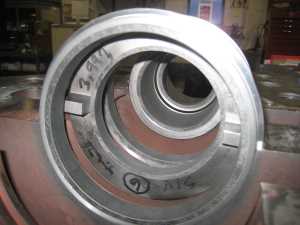- Case Studies
- Boiler Feed Water Pumps I
- Boiler Feed Water Pumps II
- Amine Stripping Pumps
- LPG Pumps
- Improve Pump Reliability I
- Improve Pump Reliability II
- Diesel Charge Pumps
Request A Quote
Sign Up for Our Newsletter
Boiler Feed Water Pumps II
How Does A Boiler Feedwater Pump Work?
A boiler feed water pump is a pump that is specifically designed to pump feed water into a steam boiler. The water may be supplied by an outside source or be returning, recycled condensate that is produced via the condensation of steam generated by the boiler. Most boiler feedwater pumps are either centrifugal pumps or positive displacement pumps.
Because of the steam pressure that develops within the boiler, the boiler feed water pump must generate extremely high pressure in order to force water into the system. For boiler feedwater pumps that run constantly, a minimum flow device is usually provided to prevent overpressuring during low flow, retuning the minimum flow to the boiler’s tank or deaerator.

Make your boiler feed pump more reliable and efficient with
Vespel® CR-6100.
Building a Better Boiler Feed Pump with Vespel® CR-6100:
The Problem
A fertilizer plant in Canada installed 2 boiler feed pumps. They were originally sized to run with one pump with a 100% capacity spare in stand-by. Soon after start-up, however, the pumps experienced problems:
- Seizure at the wear rings. In order to run reliably, the clearance at the wear rings was increased from 0.016” (0.40 mm) to 0.020” (0.50 mm)
- Increased wear ring clearance lead to reduced output capacity and the need to run both pumps in parallel
- Running both pumps created a risk of reduced boiler capacity whenever a pump was shut down and resulted in large energy losses
What they did:
- Upgraded case rings, throttle bushing, and center-stage bushing to Vespel® CR-6100
- Reduced the clearance at the wear components to 0.008” (0.20 mm)
- Verified concentricity of the rotor and quality of all fits through good repair procedures
Results of adding Vespel® CR-6100:
- Pump seizures were eliminated
- The plant could run at full capacity with 1 pump, regaining 100% spare capacity and superior plant availability
- Changing from 2-pump operation to 1-pump operation saved over $30,000/year in power, paying for the upgrade in a matter of months
Signs That Your Boiler Feed Water Pump is Not Operating at Its Best
After extended periods of nonstop operation or stop-start cycling, your boiler feedwater pump may start to lose efficiency. Decreased pump efficiency often translates to reduced plant capacity and increased energy use. However, the pump may appear to be operating normally, and users may not realize that anything is amiss. Factors that can impact the performance of your boiler feed water pump include:
A Common Boiler Feedwater Pump Problem
With ever-increasing use of solar and wind power, many conventional power plants have been required to vary their output to accommodate the peaks and valleys of renewable energy generation. This requires less continuous use and more cycling of boiler feed water pumps. The frequent starts and stops of cycling cause a significant increase in contact at the pumps’ wear rings, throttle bushings, and other wear parts. This leads to increased wear and a higher risk of pump seizure.
By way of example: A large fertilizer plant in Canada installed two boiler feed water pumps. The system was sized to operate with just one pump, with the second, 100%-capacity pump in standby. Soon after startup, however, both pumps began to experience problems that affected their performance.
- Seizure at the wear rings: In order to prevent seizure, the pumps’ clearance at the wear rings was increased from its original 0.016” (0.40 mm) to 0.020” (0.50 mm)
- Increased wear ring clearance: This increased clearance led to reduced output capacity, which, in turn, led to the need to run both pumps in parallel
Running both pumps created the risk of reduced boiler capacity whenever a pump was shut down. It also resulted in far more energy use.
How to Fix Boiler Feedwater Pump Failure
- Upgrade wear parts to DuPont™ Vespel® CR-6100 composite material
- The above allows clearance at the wear components to be reduced
- Verify concentricity of the rotor and quality of fits using proper repair procedures
Boulden helped solve the fertilizer plant’s problem by providing Vespel® CR-6100 replacement case rings, throttle bushing, and center-stage bushing for their pumps’ original metal parts.
What Happened When They Switched to Vespel® CR-6100?
By upgrading the metal wear components to Vespel® CR-6100, metal-to-metal contact points were eliminated and replaced with Vespel®-to-metal contact points. As a result:
- Pump seizures were eliminated.
- Clearance at the wear components could be reduced to 0.008” (0.20 mm)—half the OEM specification. Reduced clearance leads to improved pump efficiency
- The plant could once again run at full capacity with just one pump, regaining 100% spare capacity and improving plaint availability.
- The change from two-pump operation to one-pump operation saved more than $30,000 a year in power. These savings paid for the upgrade in a matter of months.
Contact Boulden for Vespel® CR-6100 Solutions to Your Pump Challenges
If you have a boiler feed water pump that is seizing, that costs too much to run due to low efficiency, or that is experiencing other problems, Boulden can help. We’ll work with you to upgrade your pump with Vespel® CR-6100 wear parts. We have solved boiler feedwater pump problems for customers in a wide range of industries—from power plants, refineries, and petrochemical plants to paper mills and even vegetable processing plants. We can provide the perfect solution for your unique application.
Download the Building A Better Boiler Feed Pump PDF to learn more about the advantages of using Vespel® CR-6100 wear components in your boiler feedwater pumps.